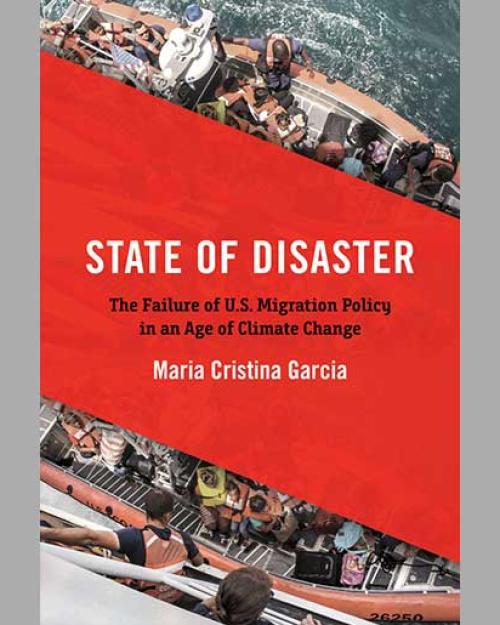Natural disasters may be impossible to prevent, but much of the devastation that occurs in their aftermath – specifically the forced displacement of people – is driven by government policy and can be averted, according to Maria Cristina Garcia, the Howard A. Newman Professor of American Studies in the College of Arts and Sciences.
In her new book, “State of Disaster: The Failure of U.S. Migration Policy in an Age of Climate Change,” published this month by the University of North Carolina Press, Garcia uses case studies from Central America and the Caribbean to show why the United States must transform its outdated migration policies to address the human devastation that is left in the wake of climate change and environmental catastrophe.
Garcia will discuss the book in a Chats in the Stacks talk on Sept. 29 at 4:30 p.m. in 107 Olin Library.
She spoke with the Chronicle about the book.
Question: Why has it been so difficult for the U.S. to develop an adequate policy for addressing climate-driven migration? Is there anything specific that has prevented it from doing so?
Answer: Our legislators have failed to grasp how quickly climate change is accelerating and the displacement it’s causing at home and abroad. At present, it is developing countries that are on the front lines of climate change, and where we see the greatest internal and cross-border migration, so it’s easy for our legislators to ignore their situation. They are not constituents, so legislators don’t feel the need to be accountable to them. Instead, they view migration as a disaster in and of itself – one that must be controlled by blocking the movement of people.
Q: What is the best argument for convincing policymakers, and also U.S. citizens, that this is a critical issue that needs to be addressed immediately?
A: I think most Americans recognize the reality of climate change, though they disagree on what’s accelerating this change. Much of what Americans are concerned about today – jobs, crumbling infrastructure, disease, the cost of food, the contamination of soil and water – can be addressed locally and nationally through a robust climate policy, if our legislators stopped politicizing this issue for selfish gain. Convincing Americans to welcome the so-called “climate refugees” is a tougher sell but we have a humanitarian duty to do so. Climate refugees are on the front lines of a problem wealthy nations created through their consumerism, exploitation of natural resources and failed development polices. The best strategy we can adopt is mitigating the effects of climate change and helping populations adapt so they can exercise the basic human right to stay home, but there will still be some populations who will be permanently displaced and will need to be resettled.
Q: Why haven’t legal pathways such as Temporary Protected Status (TPS) been effective solutions for helping climate migrants?
A: At present, TPS is the principal legal track in the immigration bureaucracy through which the United States accommodates people affected by natural disaster. There is one catch, however: To qualify for TPS, one has to be physically present in the United States at the time the environmental disaster takes place. One cannot migrate here in order to secure TPS. Who qualifies then? Those who are in the United States as tourists, students, business executives and those on temporary worker visas. Undocumented workers can also qualify. While this status offers some people safety and the opportunity to work and send remittances back home so their families and countries can rebuild, they cannot become permanent residents unless Congress creates a pathway for them. Most are eventually ordered to return home, but in some cases they don’t have a home where they can return. They have been permanently displaced. As climate change accelerates, we can expect more people to be permanently displaced from their homes and livelihoods, and the wealthier nations will need to manage resettlement. TPS won’t be a suitable response.
Q: Your book draws upon a wide range of sources, from government records and NGO reports to photographs and interviews. What was the most eye-opening discovery you made when researching this book?
A: There were several eye-opening discoveries, but let me briefly mention three. Before tackling this project, I spent a few years immersing myself in the climate science to have a better sense of the problem. I was surprised to see that many of the climate forecasts were so conservative; in many cases, change occurred much more rapidly than had been forecasted. A second surprise (much more pleasant) was to learn how proactive Cornell’s scholars are in studying climate change and helping populations around the world adapt. A third surprise was to learn that we have a historical precedent for accommodating climate refugees: The United States once had a track in immigration law for victims of “natural catastrophe,” but that track disappeared in 1980.
Q: Do you see an ideal way to address the displacement of people due to environmental disasters and climate change?
A: Natural disasters may be inevitable in a world of accelerated climate change, but human displacement reveals the failures of nation-states. They are policy disasters and those can be addressed. We need to proceed on multiple tracks at once. First, we must continue to offer humanitarian assistance to those affected by environmental disaster. Second, we have to help communities adapt to the realities of climate change in their housing, infrastructure and agriculture, so people can exercise the basic human right to stay home. Third, we have to address the individual and collective behaviors that are accelerating climate change in the first place. Fourth, we have to change the economic and foreign policies that have impoverished and indebted populations around the globe, leaving them on the front lines of a climate crisis they did not create. And fifth, we have to work with other nations to accommodate those who have been – or will be –permanently displaced from their homes.





